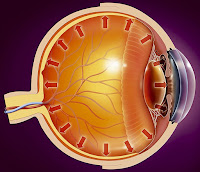Drugs affecting IOP
➧ Normal intraocular pressure (IOP) is between (10 - 20 mmHg). The average value of IOP is 15.5 mmHg with fluctuations of about 2.75 mmHg.
➧ IOP also varies with other factors such as heart rate, respiration, fluid intake, systemic medication, and topical drugs.
➧ Intraocular vascular tone is predominantly affected by CO₂; hypocarbia decreases IOP through vasoconstriction of the choroidal blood vessels and decreases the formation of aqueous humor through reduced carbonic anhydrase activity. The increased IOP associated with hypoventilation and hypercarbia occurs as a result of vasodilation of CBV and increases in central venous pressure.
A) Drugs that ↑ IOP:
1-Steroid-induced glaucoma:
Mechanism:
Is a form of open-angle glaucoma that is usually associated with topical steroid use, but it may develop with inhaled, oral, intravenous, periocular, or intravitreal steroid administration.
Risk factors:
-Preexisting primary open-angle glaucoma
-Family history of glaucoma
-High myopia, diabetes mellitus
-History of connective tissue disease (especially rheumatoid arthritis).
➧ Patients on chronic corticosteroid therapy can remain undiagnosed with an elevated IOP, which can result in glaucomatous optic nerve damage.
➧ Steroid-induced IOP elevation typically occurs within a few weeks of beginning steroid therapy. In most cases, the IOP lowers spontaneously to the baseline within a few weeks to months upon stopping the steroid. In rare instances, the IOP remains elevated.
2-Topical anticholinergic or sympathomimetic dilating drops, TCA, MAOI, antihistamines, antiparkinsonian drugs, antipsychotic medications, and antispasmolytic agents:
Mechanism:
These medications produce pupillary dilation and precipitate an attack of acute angle-closure glaucoma in anatomically predisposed eyes that have narrow angles.
3-Sulfa containing medications:
Mechanism:
Induce anterior rotation of the ciliary body causing angle-closure glaucoma. Typically, the angle closure is bilateral and occurs within the first several doses of the sulfonamide-containing medication. Patients with narrow or wide-open angles are potentially susceptible to this rare and idiosyncratic reaction.
4-Ketamine:
The effect on IOP varies. Early studies reported an increase in IOP after IV or IM administration of ketamine. Ketamine given after premedication with diazepam and meperidine does not affect IOP and IM administered ketamine may even lower IOP in children.
5-Depolarizing muscle relaxants (Succinylcholine):
Causes a transient (4–6 min) but significant increase in IOP of (10 - 20 mm Hg). Although the mechanism is unclear, the increase is not attributable simply to induced muscle fasciculations.
6-Large volume Local anesthetic:
Injecting a large volume (8–10 mL) of Local anesthetic into the orbit (e.g. peribulbar block).
7-Tracheal intubation:
Sympathetic cardiovascular responses to tracheal intubation.
8- Caffeine
B) Drugs that ↓ IOP:
In general, CNS depressants lower IOP.
1-Intravenous anesthetics and volatile agents:
Mechanism:
Relax extraocular muscle tone, depress the CNS (i.e., the diencephalon), improve the outflow of aqueous humor, and lower venous and arterial blood pressures.
➧ e.g. thiopental, propofol, etomidate, decrease in IOP by 14 - 50 % have been noted.
➧ During controlled ventilation and normocapnia, volatile inhaled anesthetics reduce IOP in proportion to the depth of anesthesia.
2-Non depolarizing neuromuscular blocking drugs:
Either do not affect IOP or produce a slight decrease.
3-Benzodiazepines:
IV administered diazepam (0.15 mg/kg) and equipotent intravenous doses of midazolam (0.03 mg/kg).
4-Narcotic premedication:
Causes no change, or only a slight decrease, in IOP.
5-Neuroleptanalgesia:
Produced by mixtures of (fentanyl and droperidol) decreases IOP by 12 % in normocapnic patients.
6- Alcohol consumption:
This leads to a transient decrease in IOP.
7- Several pretreatment regimens:
➧ IV lidocaine (1.5 mg/kg) or sufentanil (0.05–0.15 µg/kg) given 3 - 5 min. before induction.
➧ Oral administration of the centrally acting antihypertensive drug clonidine (5 µg/kg) 2 hrs before induction of anesthesia blunts the IOP response to intubation.
➧ Intranasal administration of nitroglycerin
➧ β-adrenergic receptor blocking drugs

























